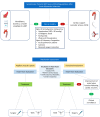Mitral Transcatheter Edge-to-Edge Repair in Acute Ischemic Mitral Regurgitation: Current Evidence and Future Perspectives
- PMID: 40351671
- PMCID: PMC12059755
- DOI: 10.31083/RCM33396
Mitral Transcatheter Edge-to-Edge Repair in Acute Ischemic Mitral Regurgitation: Current Evidence and Future Perspectives
Abstract
Acute ischemic mitral regurgitation is a rare but potentially catastrophic complication following acute myocardial infarction (AMI), characterized by severe clinical presentation and high mortality. Meanwhile, advancements in primary percutaneous coronary intervention (PCI) have reduced the incidence of acute mitral regurgitation (AMR). The surgical approach remains the standard treatment but is associated with high rates of complications and in-hospital mortality, particularly in patients with cardiogenic shock or mechanical complications, such as papillary muscle rupture. Mitral transcatheter edge-to-edge repair (M-TEER) has emerged as a minimally invasive treatment. Current evidence demonstrates the feasibility and safety of M-TEER in reducing mitral regurgitation, stabilizing hemodynamics, and improving in-hospital and short-term survival. The procedural success rate is high, with notable symptoms and functional status improvements. Mortality rates remain significant, reflecting the severity of AMR, but are lower compared to medical management alone. Challenges remain regarding the optimal timing of M-TEER, long-term device durability, and patient selection criteria. Ongoing iterations in device technology and procedural techniques are expected to enhance outcomes. This review highlights the role of M-TEER in AMR management, emphasizing the need for multidisciplinary decision-making and further research to refine M-TEER application and improve outcomes in this high-risk AMR population.
Keywords: Mitraclip; acute mitral regurgitation; mitral transcatheter edge-to-edge repair.
Copyright: © 2025 The Author(s). Published by IMR Press.
Conflict of interest statement
The authors declare no conflict of interest.
Figures



Similar articles
-
Transcatheter edge-to-edge repair in patients with mitral regurgitation and cardiogenic shock: a new therapeutic target.Curr Opin Crit Care. 2022 Aug 1;28(4):426-433. doi: 10.1097/MCC.0000000000000952. Curr Opin Crit Care. 2022. PMID: 35856980 Review.
-
Transcatheter Mitral Edge-to-Edge Repair for Treatment of Acute Mitral Regurgitation.Can J Cardiol. 2023 Oct;39(10):1382-1389. doi: 10.1016/j.cjca.2023.05.009. Epub 2023 May 18. Can J Cardiol. 2023. PMID: 37209883 Review.
-
Outcomes of mitral valve transcatheter edge-to-edge repair for patients with hemodynamic instability: A systematic review and meta-analysis.Cardiovasc Revasc Med. 2024 Oct;67:19-28. doi: 10.1016/j.carrev.2024.04.006. Epub 2024 Apr 4. Cardiovasc Revasc Med. 2024. PMID: 38584083
-
Transcatheter edge-to-edge repair in papillary muscle injury complicating acute myocardial infarction.ESC Heart Fail. 2024 Apr;11(2):1218-1227. doi: 10.1002/ehf2.14675. Epub 2024 Feb 1. ESC Heart Fail. 2024. PMID: 38303542 Free PMC article.
-
Late mitral leaflet tear after transcatheter edge-to-edge repair for acute ischaemic mitral regurgitation: a case report.Eur Heart J Case Rep. 2024 Sep 25;8(10):ytae533. doi: 10.1093/ehjcr/ytae533. eCollection 2024 Oct. Eur Heart J Case Rep. 2024. PMID: 39670283 Free PMC article.
References
-
- Sharma H, Radhakrishnan A, Nightingale P, Brown S, May J, O’Connor K, et al. Mitral Regurgitation Following Acute Myocardial Infarction Treated by Percutaneous Coronary Intervention-Prevalence, Risk factors, and Predictors of Outcome. The American Journal of Cardiology . 2021;157:22–32. doi: 10.1016/j.amjcard.2021.07.029. - DOI - PubMed
-
- Mentias A, Raza MQ, Barakat AF, Hill E, Youssef D, Krishnaswamy A, et al. Prognostic Significance of Ischemic Mitral Regurgitation on Outcomes in Acute ST-Elevation Myocardial Infarction Managed by Primary Percutaneous Coronary Intervention. The American Journal of Cardiology . 2017;119:20–26. doi: 10.1016/j.amjcard.2016.09.007. - DOI - PubMed
-
- Estévez-Loureiro R, Lorusso R, Taramasso M, Torregrossa G, Kini A, Moreno PR. Management of Severe Mitral Regurgitation in Patients With Acute Myocardial Infarction: JACC Focus Seminar 2/5. Journal of the American College of Cardiology . 2024;83:1799–1817. doi: 10.1016/j.jacc.2023.09.840. - DOI - PubMed
Publication types
LinkOut - more resources
Full Text Sources
Miscellaneous

